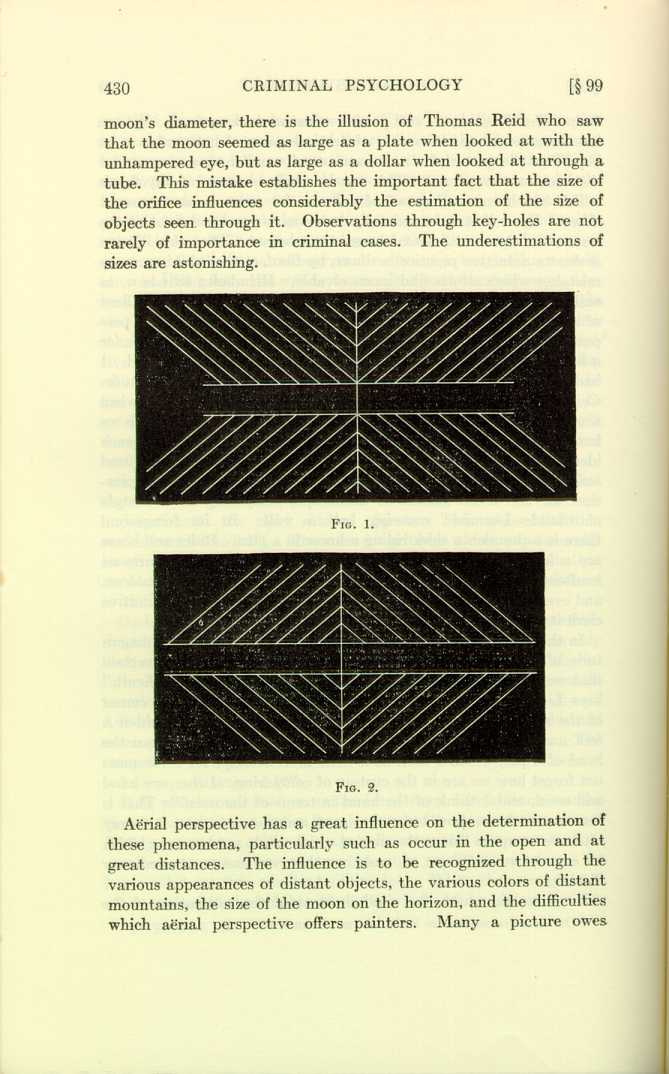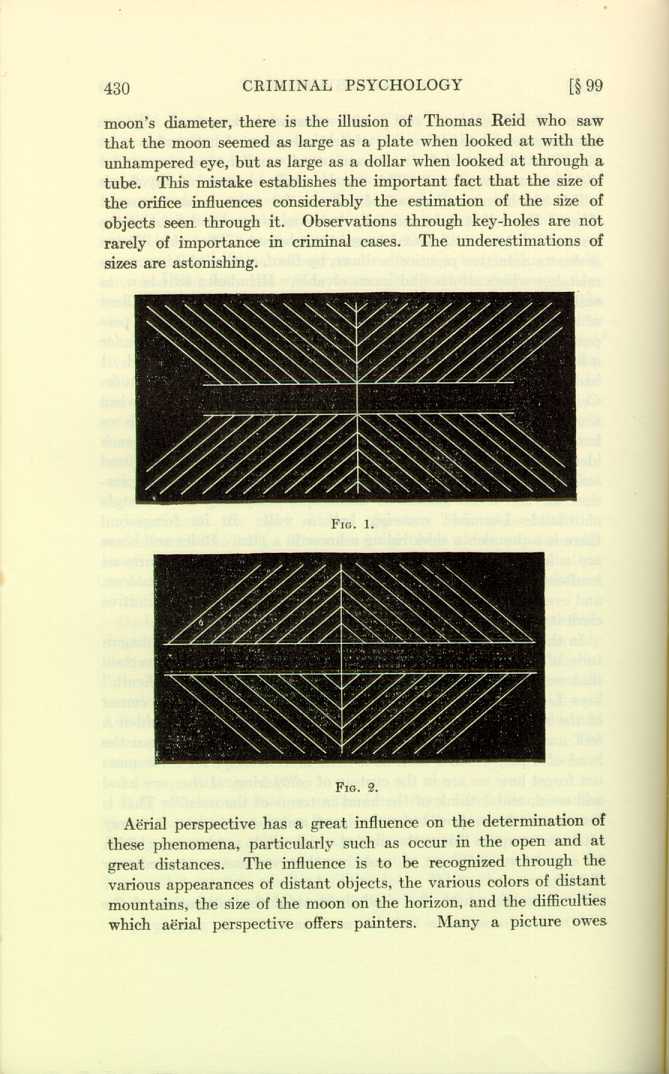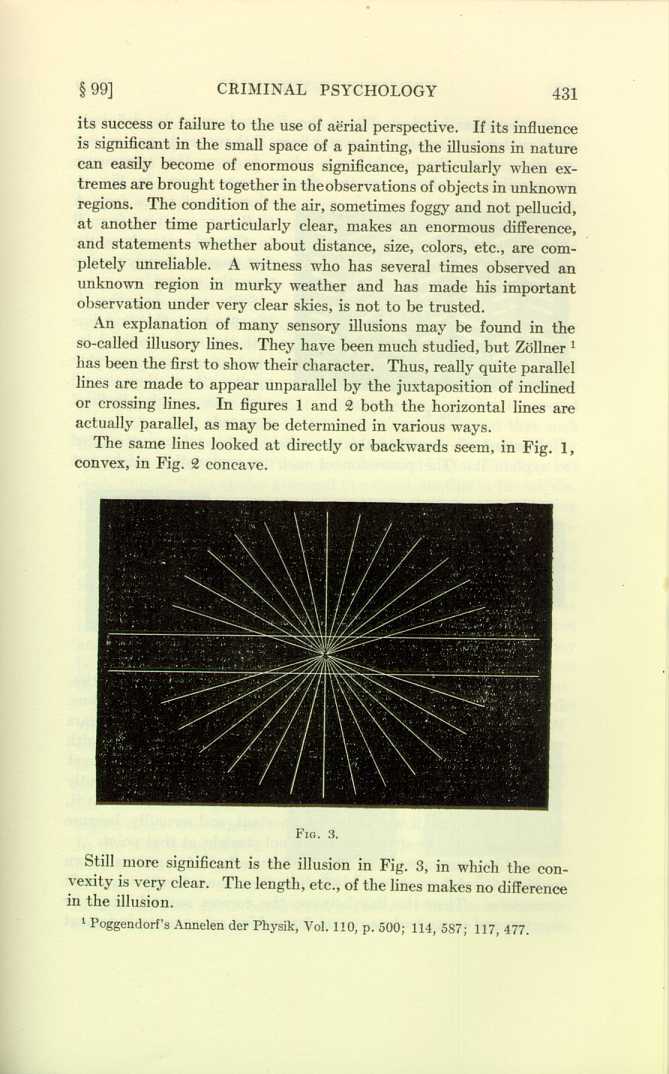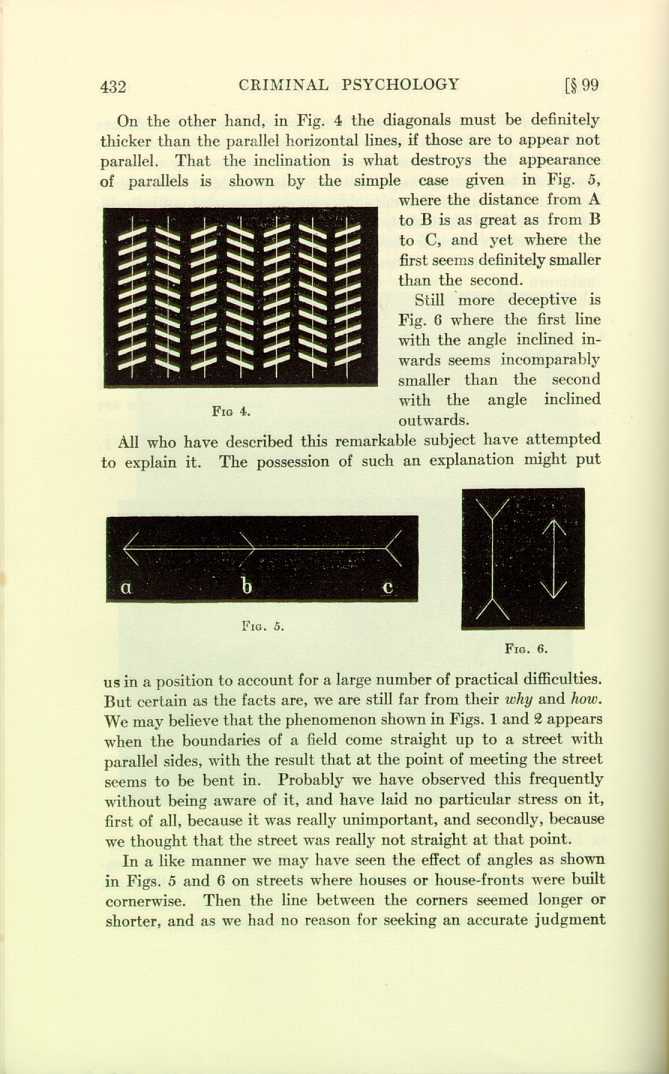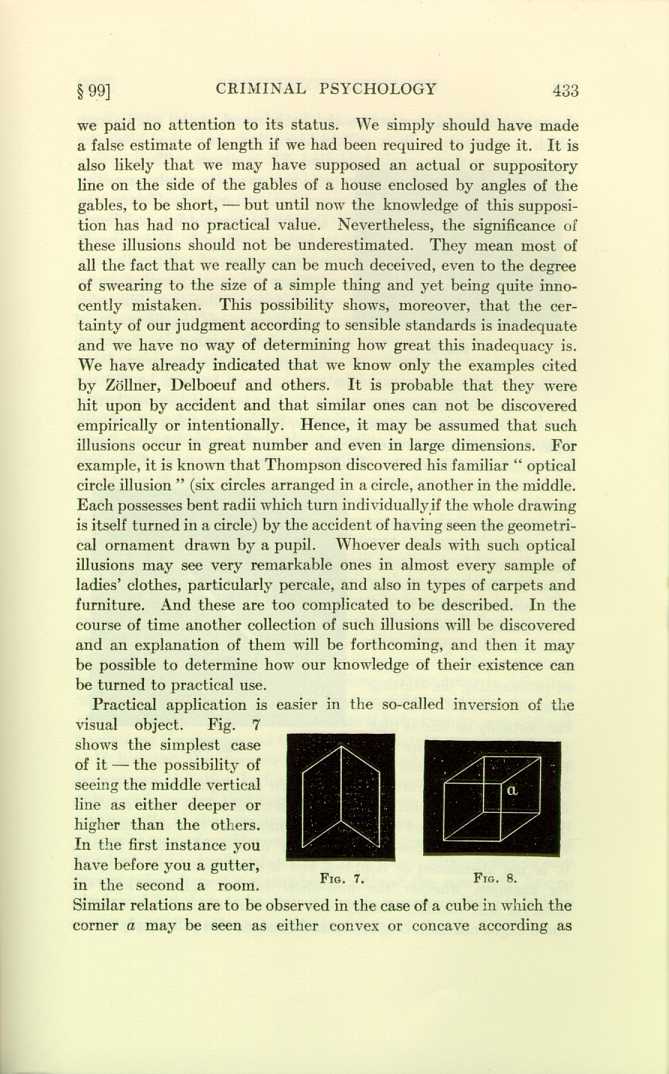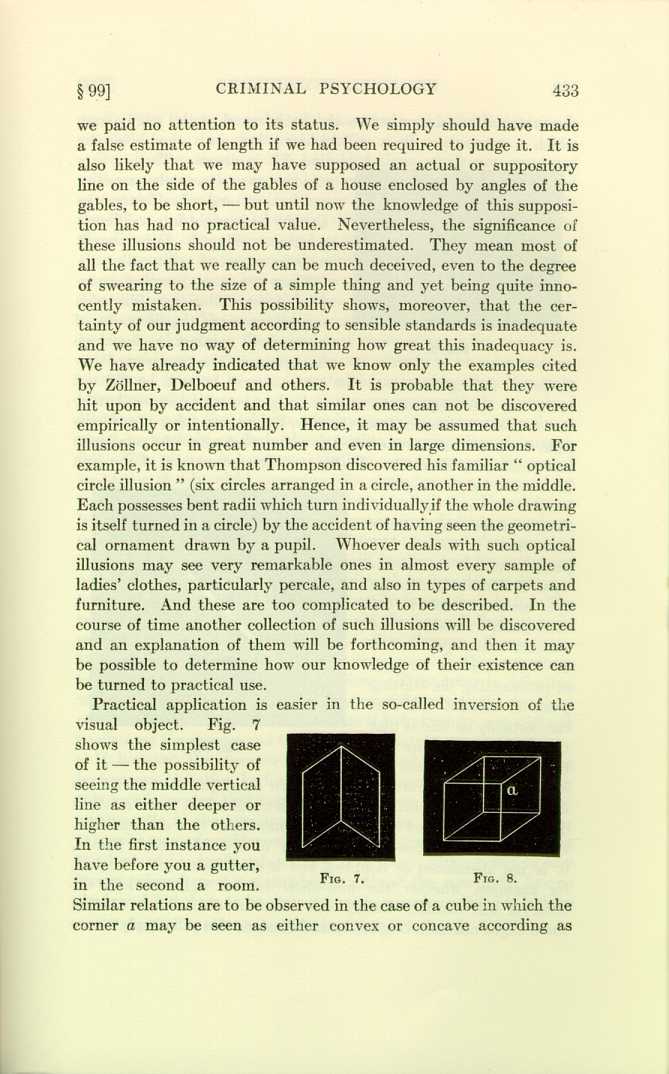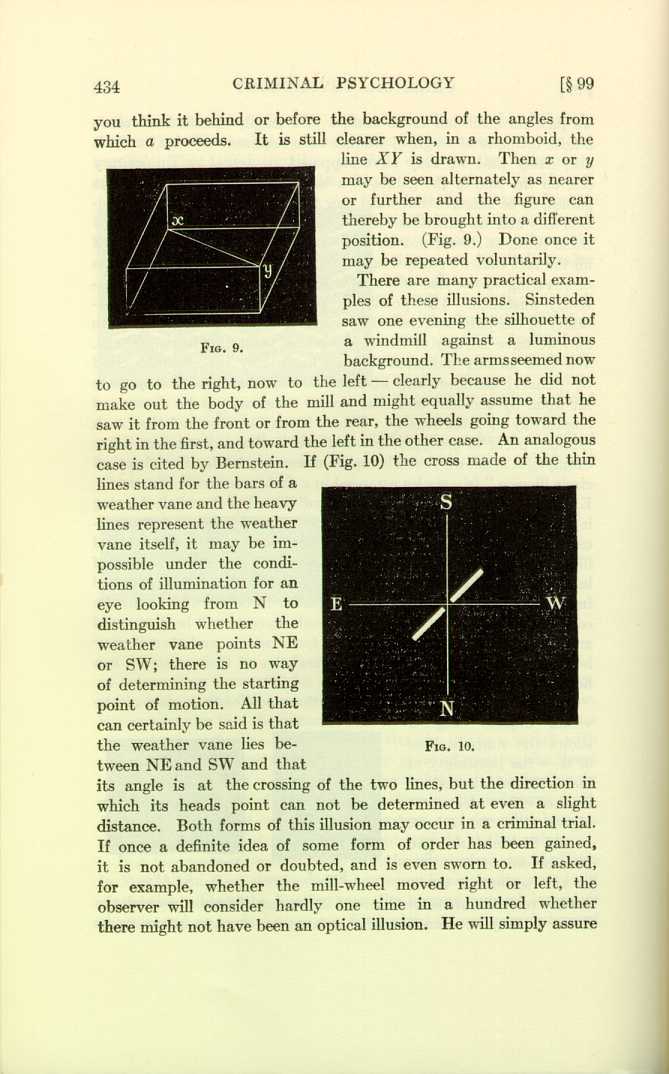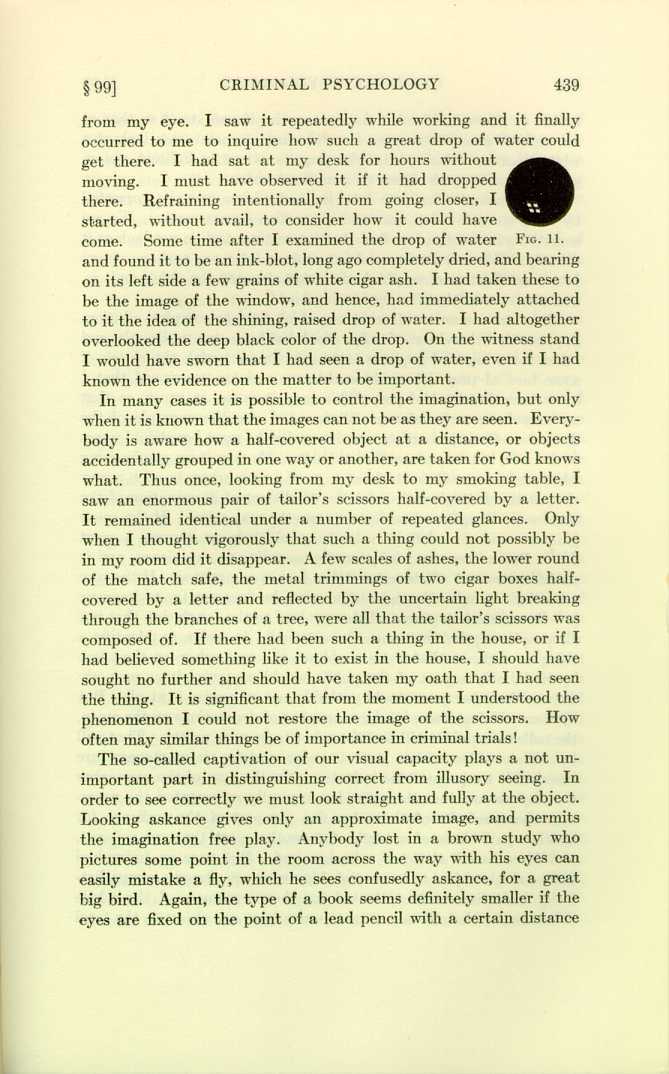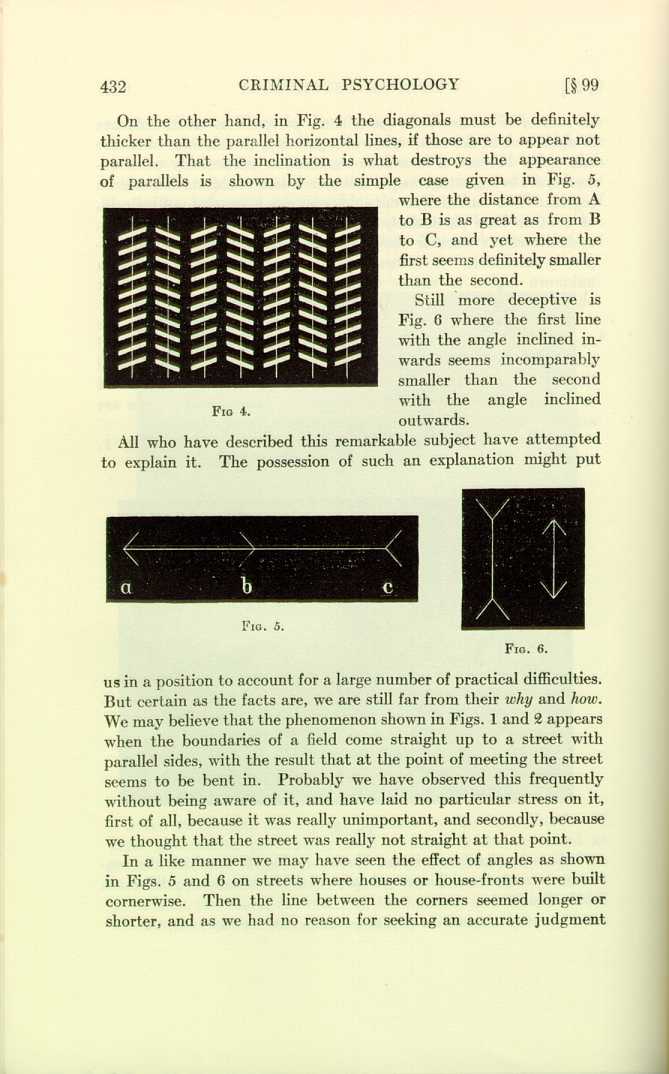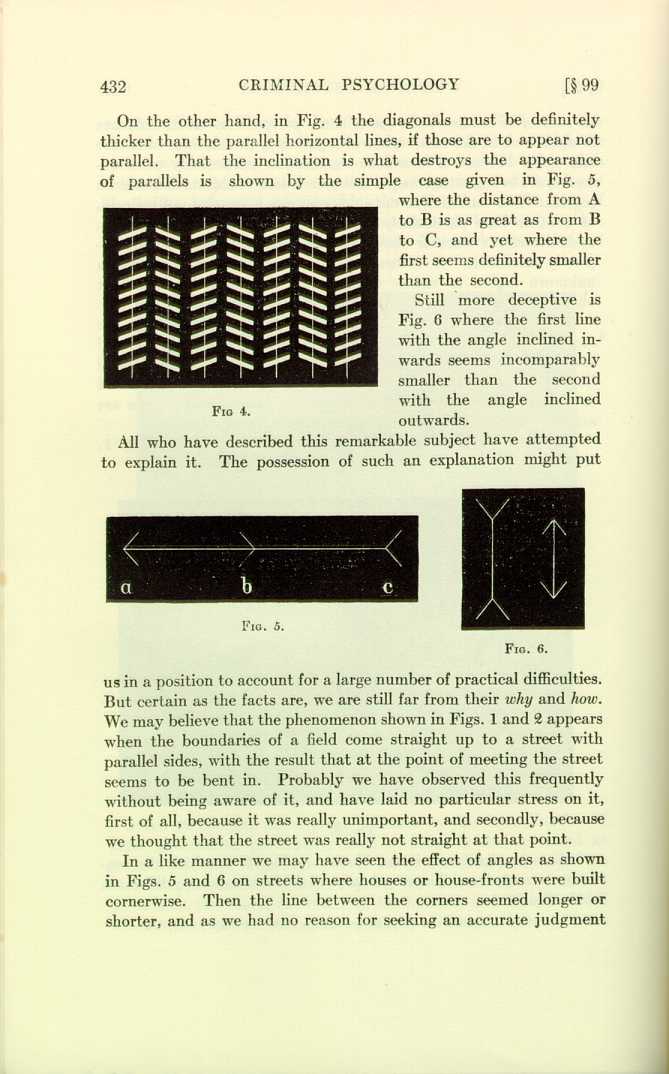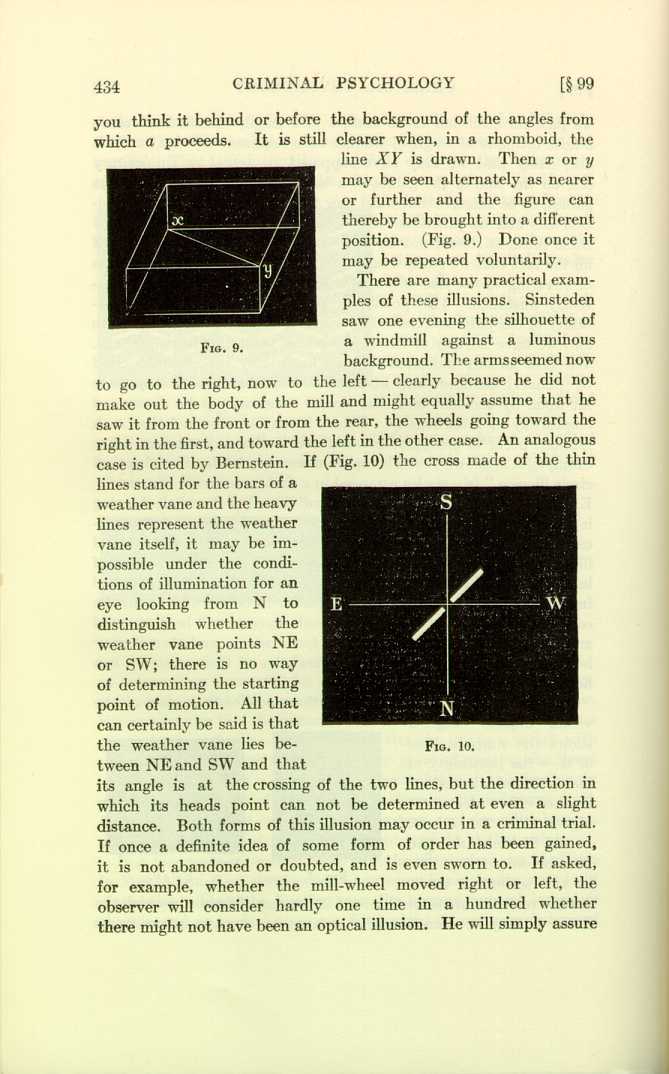Section 99. (2) Optical Illusions.
It will be best to begin the study of optical illusions with the
consideration of those conditions which cause extraordinary, lunatic
images. They are important because the illusion is recognizable
with respect to the possibility of varied interpretations by any
observer, and because anybody may experiment for himself with a
bit of paper on the nature of false optical apprehension. If we
should demonstrate no more than that the simplest conditions
often involve coarse mistakes, much will have been accomplished
for the law, since the "irrefutable evidence" of our senses would
then show itself to need corroboration. Nothing is proved with
"I have seen it myself," for a mistake in one point shows the equal
possibility of mistakes in all other points.
Generally, it may be said that the position of lines is not without
influence on the estimation of their
size.[1] Perpendicular dimensions
are taken to be somewhat greater than they are. Of two crossed
lines, the vertical one seems longer, although it is really equal to the
horizontal one. An oblong, lying on its somewhat longer side, is
taken to be a square; if we set it on the shorter side it seems to be
still more oblong than it really is. If we divide a square into equal
angles we take the nearer horizontal ones to be larger, so that we
often take an angle of thirty degrees to be forty-five. Habit has
much influence here. It will hardly be believed, and certainly is
not consciously known, that in the letter S the upper curve has a
definitely smaller radius than the lower one; but the inverted S
shows this at once. To such types other false estimations belong:
inclinations, roofs, etc., appear so steep in the distance that it is
said to be impossible to move on them without especial help. But
whoever does move on them finds the inclination not at all so great.
Hence, it is necessary, whenever the ascension of some inclined
plane is declared impossible, to inquire whether the author of the
declaration was himself there, or whether he had judged the thing
at a distance.
Slight crooks are underestimated.
Exner[2] rightly calls attention
to the fact that in going round the rotunda of the Viennese Prater,
he always reached the exit much sooner than he expected. This is
due to the presence of slight deviations and on them are based the
numerous false estimates of distance and the curious fact that
people, on being lost at night in the woods, go round in a significantly
small circle. It is frequently observed that persons, who for one
reason or another, i. e., robbery, maltreatment, a burglarious assault,
etc., had fled into the woods to escape, found themselves at daybreak,
in spite of their flight, very near the place of the crime, so
that their honesty in fleeing seems hardly believable. Nevertheless
it may be perfectly trustworthy, even though in the daytime the fugitive
might be altogether at home in the woods. He has simply underestimated
the deviations he has made, and hence believes that he
has moved at most in a very flat arc. Supposing himself to be
going forward and leaving the wood, he has really been making a
sharp arc, and always in the same direction, so that his path has
really been circular.
Some corroboration for this illusion is supplied by the fact that
the left eye sees objects on the left too small, while the right eye
underestimates the right side of objects. This underestimation
varies from 0.3 to 0.7%. These are magnitudes which may naturally
be of importance, and which in the dark most affect deviations that
are closely regarded on the inner side of the eye—i. e., deviations
to the left of the left eye or the right of the right eye.
Such confusions become most troublesome when other estimations
are added to them. So long as the informant knows that he has only
been estimating, the danger is not too great. But as a rule the informant
does not regard his conception as an estimate, but as certain
knowledge. He does not say, "I estimate," he says, "It is so."
Aubert tells how the astronomer Förster had a number of educated
men, physicians, etc., estimate the diameter of the moon. The
estimation varied from 1" to 8" and more. The proper diameter
is 1.5" at a distance of 12".
It is well known that an unfurnished room seems much smaller
than a furnished one, and a lawn covered with snow, smaller than a
thickly-grown one. We are regularly surprised when we find an
enormous new structure on an apparently small lot, or when a lot
is parcelled out into smaller building lots. When they are planked
off we marvel at the number of planks which can be laid on the surface.
The illusions are still greater when we look upward. We are
less accustomed to estimation of verticals than of horizontals. An
object on the gutter of a roof seems much smaller than at a similar
distance on the ground. This can be easily observed if any figure
which has been on the roof of a house for years is once brought
down. Even if it is horizontally twice as far as the height of the
house, the figure still seems larger than before. That this illusion
is due to defective practice is shown by the fact that children make
mistakes which adults find inconceivable. Helmholtz tells how, as
child, he asked his mother to get him the little dolls from the gallery
of a very high tower. I remember myself that at five years I proposed
to my comrades to hold my ankles so that I could reach for
a ball from the second story of a house down to the court-yard. I
had estimated the height as one-twelfth of its actual magnitude.
Certain standards of under and overestimations are given us when
there is near the object to be judged an object the size of which we
know. The reason for the fact that trees and buildings get such
ideal sizes on so-called heroic landscape is the artistically reduced
scale. I know that few pictures have made such a devilish impression
on me as an enormous landscape, something in the style
of Claude Lorraine, covering half a wall. In its foreground
there is to be seen a clerk riding a horse in a glen. Rider and horse
are a few inches high, and because of this the already enormous
landscape becomes frightfully big. I saw the picture as a student,
and even now I can describe all its details. Without the diminutive
clerk it would have had no particular effect.
In this connection we must not forget that the relations of magnitude
of things about us are, because of perspective, so uncertain
that we no longer pay any attention to them. "I find it difficult,"
says Lipps,[3] "to believe that
the oven which stands in the corner
of the room does not look larger than my hand when I hold it a
foot away from my eyes, or that the moon is not larger than the
head of a pin, which I look at a little more closely.... We must
not forget how we are in the custom of comparing. I compare hand
and oven, and I think of the hand in terms of the oven." That is
because we know how large the hand and the oven are, but very
often we compare things the sizes of which we do not know, or which
we can not so easily get at, and then there are many extraordinary
illusions.
In connection with the cited incident of the estimation of the
moon's diameter, there is the illusion of Thomas Reid who saw
that the moon seemed as large as a plate when looked at with the
unhampered eye, but as large as a dollar when looked at through a
tube. This mistake establishes the important fact that the size of
the orifice influences considerably the estimation of the size of
objects seen through it. Observations through key-holes are not
rarely of importance in criminal cases. The underestimations of
sizes are astonishing.
Aërial perspective has a great influence on the determination of
these phenomena, particularly such as occur in the open and at
great distances. The influence is to be recognized through the
various appearances of distant objects, the various colors of distant
mountains, the size of the moon on the horizon, and the difficulties
which aërial perspective offers painters. Many a picture owes
its success or failure to the use of aërial perspective. If its influence
is significant in the small space of a painting, the illusions in nature
can easily become of enormous significance, particularly when extremes
are brought together in the observations of objects in unknown
regions. The condition of the air, sometimes foggy and not pellucid,
at another time particularly clear, makes an enormous difference,
and statements whether about distance, size, colors, etc., are completely
unreliable. A witness who has several times observed an
unknown region in murky weather and has made his important
observation under very clear skies, is not to be trusted.
An explanation of many sensory illusions may be found in the
so-called illusory lines. They have been much studied, but
Zöllner[4]
has been the first to show their character. Thus, really quite parallel
lines are made to appear unparallel by the juxtaposition of inclined
or crossing lines. In figures 1 and 2 both the horizontal lines are
actually parallel, as may be determined in various ways.
The same lines looked at directly or backwards seem, in Fig. 1,
convex, in Fig. 2 concave.
Still more significant is the illusion in Fig. 3, in which the
convexity
is very clear. The length, etc., of the lines makes no difference
in the illusion.
On the other hand, in Fig. 4 the diagonals must be definitely
thicker than the parallel horizontal lines, if those are to appear not
parallel. That the inclination is what destroys the appearance
of parallels is shown by the simple case given in Fig. 5,
where the distance from A
to B is as great as from B
to C, and yet where the
first seems definitely smaller
than the second.
Still more deceptive is
Fig. 6 where the first line
with the angle inclined inwards
seems incomparably
smaller than the second
with the angle inclined
outwards.
All who have described this remarkable subject have attempted
to explain it. The possession of such an explanation might put
us in a position to account for a large number of practical difficulties.
But certain as the facts are, we are still far from their why and how.
We may believe that the phenomenon shown in Figs. 1 and 2 appears
when the boundaries of a field come straight up to a street with
parallel sides, with the result that at the point of meeting the street
seems to be bent in. Probably we have observed this frequently
without being aware of it, and have laid no particular stress on it,
first of all, because it was really unimportant, and secondly, because
we thought that the street was really not straight at that point.
In a like manner we may have seen the effect of angles as shown
in Figs. 5 and 6 on streets where houses or house-fronts were built
cornerwise. Then the line between the corners seemed longer or
shorter, and as we had no reason for seeking an accurate judgment
we paid no attention to its status. We simply should have made
a false estimate of length if we had been required to judge it. It is
also likely that we may have supposed an actual or suppository
line on the side of the gables of a house enclosed by angles of the
gables, to be short,—but until now the knowledge of this supposition
has had no practical value. Nevertheless, the significance of
these illusions should not be underestimated. They mean most of
all the fact that we really can be much deceived, even to the degree
of swearing to the size of a simple thing and yet being quite innocently
mistaken. This possibility shows, moreover, that the certainty
of our judgment according to sensible standards is inadequate
and we have no way of determining how great this inadequacy is.
We have already indicated that we know only the examples cited
by Zöllner, Delboeuf and others. It is probable that they were
hit upon by accident and that similar ones can not be discovered
empirically or intentionally. Hence, it may be assumed that such
illusions occur in great number and even in large dimensions. For
example, it is known that Thompson discovered his familiar "optical
circle illusion" (six circles arranged in a circle, another in the middle.
Each possesses bent radii which turn individually if the whole drawing
is itself turned in a circle) by the accident of having seen the geometrical
ornament drawn by a pupil. Whoever deals with such optical
illusions may see very remarkable ones in almost every sample of
ladies' clothes, particularly percale, and also in types of carpets and
furniture. And these are too complicated to be described. In the
course of time another collection of such illusions will be discovered
and an explanation of them will be forthcoming, and then it may
be possible to determine how our knowledge of their existence can
be turned to practical use.
Practical application is easier in the so-called inversion of the
visual object. Fig. 7
shows the simplest case
of it—the possibility of
seeing the middle vertical
line as either deeper or
higher than the others.
In the first instance you
have before you a gutter,
in the second a room.
Similar relations are to be observed in the case of a cube in which the
corner a may be seen as either convex or concave according as
you think it behind or before the background of the angles from
which
a proceeds. It is still clearer when, in a rhomboid, the
line
XY is drawn. Then
x or
y
may be seen alternately as nearer
or further and the figure can
thereby be brought into a different
position. (Fig. 9.) Done once it
may be repeated voluntarily.
There are many practical examples
of these illusions. Sinsteden
saw one evening the silhouette of
a windmill against a luminous
background. The arms seemed now
to go to the right, now to the left—clearly because he did not
make out the body of the mill and might equally assume that he
saw it from the front or from the rear, the wheels going toward the
right in the first, and toward the left in the other case. An analogous
case is cited by Bernstein. If (Fig. 10) the cross made of the thin
lines stand for the bars of a
weather vane and the heavy
lines represent the weather
vane itself, it may be impossible
under the conditions
of illumination for an
eye looking from N to
distinguish whether the
weather vane points NE
or SW; there is no way
of determining the starting
point of motion. All that
can certainly be said is that
the weather vane lies between
NE and SW and that
its angle is at the crossing of the two lines, but the direction in
which its heads point can not be determined at even a slight
distance. Both forms of this illusion may occur in a criminal trial.
If once a definite idea of some form of order has been gained,
it is not abandoned or doubted, and is even sworn to. If asked,
for example, whether the mill-wheel moved right or left, the
observer will consider hardly one time in a hundred whether
there might not have been an optical illusion. He will simply assure
us that the thing was as he thinks he saw it, and whether he saw it
correctly is purely a matter of luck.
To all these illusions may be added those which are connected
with movement or are exposed by movement. During the movement
of certain bodies we can distinguish their form only under definite
conditions. As their movement increases they seem shorter in
the direction of movement and as it decreases they seem broader
than normally. An express train with many cars seems shorter when
moving directly near us, and rows of marching men seem longer.
The illusion is most powerful when we look through a stationary
small opening. The same thing occurs when we move quickly past
bodies, for this makes them seem very short as we go by.
Of such cases sense-illusion does not constitute an adequate
explanation; it must be supplemented by a consideration of certain
inferences which are, in most instances, comparatively
complex.[5]
We know, e. g., that objects which appear to us unexpectedly at
night, particularly on dark, cloudy nights, seem inordinately magnified.
The process is here an exceedingly complex one. Suppose I
see, some cloudy night, unexpectedly close to me a horse whose
environment, because of the fog, appears indistinct. Now I know
from experience that objects which appear from indistinct environments
are as a rule considerably distant. I know, further, that
considerably distant objects seem much smaller, and hence I must
assume that the horse, which in spite of its imaginary distance
appears to retain its natural size, is really larger than it is. The
train of thought is as follows: "I see the horse indistinctly. It
seems to be far away. It is, in spite of its distance, of great size.
How enormous it must be when it is close to me!" Of course these
inferences are neither slow nor conscious. They occur in reflection
with lightning-like swiftness and make no difference to the certainty
of the instantaneous judgment. Hence it is frequently very difficult
to discover the process and the mistake it contains.
If, however, the observer finds an inexplicable hiatus in an event
he happens to notice, he finds it strange because unintelligible. In
this way is created that notion of strangeness which often plays so
great a rôle in the examination of witnesses. Hence when under
otherwise uncomfortable conditions, I see a horse run without hearing
the beat of his hoofs, when I see trees sway without feeling any
storm; when I meet a man who, in spite of the moonlight, has no
shadow, I feel them to be very strange because something is lacking
in their logical development as events. Now, from the moment
a thing becomes strange to an individual his perceptions are no
longer reliable, it is doubtful whether he knows what he has really
experienced before his world became strange to him. Add to this
that few people are unwilling to confess that they felt ill at ease,
that perhaps they do not even know it,
[6]
and you get the complicated
substitution of sensory illusions and uncanny sensation, the one
causing the other, the other magnifying the one, and so on until
the whole affair is turned into something quite unrecognizable.
So we find ourselves in the presence of one of the inexplicable situations
of the reality of which we are assured by the most trustworthy
individuals.
To magnify this phenomenon, we need only think of a few slightly
abnormal cases. It has already been indicated that there are many
such which are not diseased, and further, that many diseased cases
occur which are not known as such, at least, as being so much so
as to make the judge call in the doctor. This is the more likely
because there are frequently, if I may say so, localized diseases
which do not exhibit any extraordinary symptoms, at least to laymen,
and hence offer no reason for calling in experts. If we set aside all
real diseases which are connected with optical illusions as not concerning
us, there are still left instances enough. For example, any
medical text-book will tell you that morphine fiends and victims of
the cocaine habit have very strong tendencies to optical illusions
and are often tortured by them. If the disease is sufficiently advanced,
such subjects will be recognized by the physician at a single
glance. But the layman can not make this immediate diagnosis.
He will get the impression that he is dealing with a very nervous
invalid, but not with one who is subject to optical illusions. So,
we rarely hear from a witness that he knows such people, and certainly
not that he is one himself. A very notable oculist, Himly,
was the first to have made the observation that in the diseased
excitability of the retina every color is a tone higher. Luminous
black looks blue, blue looks violet, violet looks red, red looks yellow.
Torpor of the retina inverts the substitution.
Dietz[7] tells of color-illusions
following upon insignificant
indigestion;
Foderè of hysterics who see everything reversed, and
Hoppe[8]
says, "If the order of the rods and cones of the retina is somewhat
disturbed by an inflammatory touch, the equilibrium of vision is
altered and changes in size, in form, or appearance occur." Naturally
the criminalist can not perceive slight indigestion, weak hysteria,
or an inflamed area in the retina when he is examining witnesses, yet
false observations like those described may have a definite influence
upon the decision in a case.
If such abnormal occasions are lacking the reasons for optical
illusions are of another nature. As a rule optical illusions occur
when there is an interruption in the communication between the
retina, the sense of movement, and the sense of touch, or when we
are prevented from reducing the changes of the retinal image to the
movement of our body or of our eyes. This reduction goes on so
unconsciously that we see the idea of the object and its condition
as a unit. Again, it is indubitable that the movement of the body
seems quicker when we observe it with a fixed glance than when we
follow it with our eyes. The difference may be so significant that it
is often worth while, when much depends on determining the speed
of some act in a criminal case, to ask how the thing was looked at.
Fechner has made a far-reaching examination of the old familiar
fact that things on the ground appear to run when we ride by them
rapidly.[9] This fact may be
compared with the other, that when
you look directly into swift-moving water from a low bridge, the
latter seems all of a sudden to be swimming rapidly up stream,
though the water does not appear to stand still. Here some unknown
factor is at work and may exercise considerable influence on many
other phenomena without our being able to observe the results.
To this class may be added the extraordinary phenomenon that
from the train objects easily seem too near and hence appear smaller
than they are. It may be, however, that the converse is true and
objects appear smaller, or at least shorter, and that inasmuch as we
are in the habit of attributing the diminution of size in objects to
their distance, we tax the latter as false. So much is certain—that
whenever we ourselves move quickly we make false judgments of
size, distance, and even color. The last may be due to the fact that
during a quick passage, colors may so compose themselves, that
green and red become white, and blue and yellow, green, etc. I
believe that all these illusions are increasing in connection with the
spread of bicycling, inasmuch as many observations are made from
the fleeting wheel and its motion tends to increase the illusions
considerably. Concerning the differences in movement
Stricker[10]
says: "If I lie on my back and see a bird fly in the uniformly blue
heaven, I recognize the movement although I have no object with
which to compare it. This can not be explained by the variety of
points on the retina which are affected, for when the bird pauses
and I turn my eye, I know that it is not moving." The last argument
is not correct. If the bird is sitting on a branch I know, in spite of
all my occipital movement, that it is quiet, but only because I perceive
and observe the bird's immobility. If, however, I lie on my
back like Stricker and see above me a bird of the class that, so to
speak, swim motionless in the air for minutes at a time, and if then
I turn my head, I can not tell when the bird begins to move. Here
then we have no exception to the general rule and can always say
that we are speaking of movement optically perceived when the
rays issuing from any body progressively touch various points on
the retina. And since this occurs when we are in motion as well as
when the object is in motion it happens that we can not locate the
movement, we cannot say whether it be in us or in the object.
Of course, the possibility that fanciful images may appear during
movement is familiar. If I sit quietly in the forest and at some
distance see a stone or a piece of wood or a little heap of dried leaves,
etc., it may be that, because of some illusion, I take it to be a rolled
up hedgehog, and it may happen that I am so convinced of the
nature of the object while I am looking at it that I see how the hedgehog
stretches itself, sticks out its paws and makes other movements.
I remember one winter when, because of some delay, a commission
on which I was serving had failed to reach a village not far from the
capital. We had gone to investigate a murder case and had found
the body frozen stiff. The oven in the room was heated and the
grave-digger placed the stiff body near the oven in order to thaw it
out. We at this time were examining the place. After a while I
was instructed by the examining justice to see about the condition
of the corpse, and much to my disgust, I found it sitting near the
oven, bent over. It had thawed out and collapsed. During the
subsequent obduction I saw most clearly how the corpse made all
kinds of movements, and even after the section, during the dictation
of the protocol, my imagination still seemed to see the corpse moving
a hand or a foot.
The imagination may also cause changes in color. Once, I saw
on my desk, which stood next to a window, a great round drop
of water on the left side of which the panes of the window
were reflected. (Fig. 11). The whole business was about a meter
from my eye. I saw it repeatedly while working and it finally
occurred to me to inquire how such a great drop of water could
get there. I had sat at my desk for hours without
moving. I must have observed it if it had dropped
there. Refraining intentionally from going closer, I
started, without avail, to consider how it could have
come. Some time after I examined the drop of water FIG. 11.
and found it to be an ink-blot, long ago completely dried, and bearing
on its left side a few grains of white cigar ash. I had taken these to
be the image of the window, and hence, had immediately attached
to it the idea of the shining, raised drop of water. I had altogether
overlooked the deep black color of the drop. On the witness stand
I would have sworn that I had seen a drop of water, even if I had
known the evidence on the matter to be important.
In many cases it is possible to control the imagination, but only
when it is known that the images can not be as they are seen. Everybody
is aware how a half-covered object at a distance, or objects
accidentally grouped in one way or another, are taken for God knows
what. Thus once, looking from my desk to my smoking table, I
saw an enormous pair of tailor's scissors half-covered by a letter.
It remained identical under a number of repeated glances. Only
when I thought vigorously that such a thing could not possibly be
in my room did it disappear. A few scales of ashes, the lower round
of the match safe, the metal trimmings of two cigar boxes
half-covered by a letter and reflected by the uncertain light breaking
through the branches of a tree, were all that the tailor's scissors was
composed of. If there had been such a thing in the house, or if I
had believed something like it to exist in the house, I should have
sought no further and should have taken my oath that I had seen
the thing. It is significant that from the moment I understood the
phenomenon I could not restore the image of the scissors. How
often may similar things be of importance in criminal trials!
The so-called captivation of our visual capacity plays a not
unimportant part in distinguishing correct from illusory seeing. In
order to see correctly we must look straight and fully at the object.
Looking askance gives only an approximate image, and permits
the imagination free play. Anybody lost in a brown study who
pictures some point in the room across the way with his eyes can
easily mistake a fly, which he sees confusedly askance, for a great
big bird. Again, the type of a book seems definitely smaller if the
eyes are fixed on the point of a lead pencil with a certain distance
before or above the book. And yet again, if you stand so that at
an angle of about 90 degrees from the fixation point, you look at a
white door in a dark wall, observing its extent in indirect vision,
you will find it much higher than in direct vision.
These examples indicate how indirect vision may be corrected
by later correct vision, but such correction occurs rarely. We see
something indirectly; we find it uninteresting, and do not look at it
directly. When it becomes of importance later on, perhaps enters
into a criminal case, we think that we have seen the thing as it is,
and often swear that "a fly is a big bird."
There are a number of accidents which tend to complete illusion.
Suppose that the vision of a fly, which has been seen indirectly and
taken for a big bird happens to be synchronous with the shriek of
some bird of prey. I combine the two and am convinced that I
have seen that bird of prey. This may increase, so much so that
we may have series of sense-illusions. I cite the example of the
decorative theatrical artist, who can make the most beautiful images
with a few, but very characteristic blots. He does it by emphasizing
what seems to us characteristic, e. g., of a rose arbor, in such a way
that at the distance and under the conditions of illumination of the
theatre we imagine we really see a pretty rose arbor. If the scene
painter could give definite rules he would help us lawyers a great
deal. But he has none, he proceeds according to experience, and is
unable to correct whatever mistakes he has committed. If the rose
arbor fails to make the right impression, he does not try to improve
it—he makes a new one. This may lead to the conclusion that not
all people require the same characteristics in order to identify a
thing as such, so that if we could set the rose arbor on the stage
by itself, only a part of the public would recognize it as properly
drawn, the other part would probably not recognize it at all. But
if, of an evening, there is a large number of decorations on the stage,
the collective public will find the arbor to be very pretty. That will
be because the human senses, under certain circumstances, are
susceptible to sympathetic induction. In the case of the rose arbor
we may assume that the artist has typically represented the necessary
characteristics of the arbor for one part of the audience, for
another part those of a castle, for another part those of a forest,
and for a fourth those of a background. But once an individual
finds a single object to be correct, his senses are already sympathetically
inductive, i. e., captivated for the correctness of the whole
collection, so that the correctness passes from one object to the total
number. Now, this psychic process is most clear in those optical
illusions which recently have been much on public exhibition (the
Battle of Gravelotte, the Journey of the Austrian Crown Prince in
Egypt, etc.). The chief trick of these representations is the presenting
of real objects, like stones, wheels, etc., in the foreground in such a
way that they fuse unnoticeably with the painted picture. The
sense of the spectator rests on the plastic objects, is convinced of
their materiality and transfers the idea of this plasticity to the
merely pictured. Thus the whole image appears as tri-dimensional.
The decorations of great parks at the beginning of the last century
indicate that illumination and excited imagination are not alone in
causing such illusions. Weber tells ecstatically of an alley in Schwetzing
at the end of which there was a highly illuminated concave
wall, painted with a landscape of mountains and water-falls. Everybody
took the deception for a reality because the eye was captivated
and properly inducted. The artist's procedure must have been
psychologically correct and must have counted upon the weakness
of our observation and intellection. Exner points to the simple
circumstance that we do not want to see that things under certain
conditions must terminate. If we draw a straight line and cover
an end with a piece of paper, every one wonders that the line is not
longer when the paper is removed.
I know of no case in criminal procedure where illusions of this
kind might be of importance, but it is conceivable that such illusions
enter in numberless instances. This is especially susceptible of
observation when we first see some region or object hastily and then
observe it more accurately. We are astonished how fundamentally
false our first conception was. Part of this falseness may be adduced
to faults of memory, but these play little or no part if the time is
short and if we are able to recall that the false conception appeared
just as soon as we observed the situation in question. The essential
reason for false conception is to be found only in the fact that our
first hasty view was incorrectly inducted, and hence, led to illusions
like those of the theatre. Thus, it is possible to take a board fence
covered at points with green moss, for a moss-covered rock, and
then to be led by this to see a steep cliff. Certain shadows may so
magnify the size of the small window of an inn that we may take it
to be as large as that of a sitting room. And if we have seen just one
window we think all are of the same form and are convinced that
the inn is a mansion. Or again, we see, half-covered, through the
woods, a distant pool, and in memory we then see the possibly,
but not necessarily, present river. Or perhaps we see a church spire,
and possibly near it the roof of a house rises above the trees; then
we are inducted into having seen a village, although there really are
visible only the church and the house.
These illusions again, I must repeat, are of no importance if they
are at all doubted, for then the truth is ascertained. When, however,
they are not doubted and are sworn to, they cause the greatest
confusion in trials. A bar-room quarrel, a swung cane, and a red
handkerchief on the head, are enough to make people testify to
having seen a great brawl with bloody heads. A gnawing rat, a
window accidentally left open through the night, and some misplaced,
not instantaneously discovered object, are the ingredients
of a burglary. A man who sees a rather quick train, hears a shrill
blowing of the whistle, and sees a great cloud, may think himself
the witness of a wreck. All these phenomena, moreover, reveal
us things as we have been in the habit of seeing them. I repeat,
here also, that the photographic apparatus, in so far as it does not
possess a refracting lens, shows things much more truly than our
eye, which is always corrected by our memory. If I permit a man
sitting on a chair to be photographed, front view, with his legs
crossed and stretched far out, the result is a ludicrous picture because
the boots seem immensely larger than the head of the subject. But
the photograph is not at fault, for if the subject is kept in the same
position and then the apparent size of head and boot are measured,
we get accurately the same relation as on the photograph. We know
by experience how big a head is. And hence, we ordinarily see all
relations of size in proper proportion. But on the photograph we
can not apply this "natural" standard because it is not given in
nature, and we blame the camera.
If, in a criminal case, we are dealing with a description of size,
and it is given as it is known from experience, not as it really appears,
then if experience has deceived us, our testimony is also wrong,
although we pretend to have testified on the basis of direct
sense-perception.
The matter of after-images, probably because of their short
duration, is of no criminalistic importance. I did once believe that
they might be of considerable influence on the perception of witnesses,
but I have not succeeded in discovering a single example in which
this influence is perceptible.
On the other hand, the phenomenon of irradiation, the appearance
of dark bodies as covered with rays of light by adjacent luminosities,
is of importance. This phenomenon is well-known, as are Helmholtz's
and Plateau's explanations of it. But it is not sufficiently
applied. One needs only to set a white square upon the blackest possible
ground and at the same time a similar black square of equal size
on a white ground, and then to place them under a high light, to
perceive how much larger the white square appears to be. That such
phenomena often occur in nature need not be expounded. Whenever
we are dealing with questions of size it is indubitably necessary to
consider the color of the object and its environment with respect
to its background and to the resulting irradiation.
[[ id="n99.1"]]
Cf. Lotze: Medizinische Psychologie. Leipzig 1852.
[[ id="n99.2"]]
Cf. Entwurf, etc.
[[ id="n99.3"]]
Die Grundtatsachen des Seelenlebens. Bonn 1883.
[[ id="n99.4"]]
Poggendorf's Annelen der Physik, Vol. 110, p. 500; 114, 587; 117, 477.
[[ id="n99.5"]]
W. Larden: Optical Illusion. Nature LXIII, 372 (1901).
[[ id="n99.6"]]
H. Gross: Lehrbuch für den Ausforschungsdienst der Gendarmerie.
[[ id="n99.7"]]
Über die Quelle der Sinnestäuschungen. Magazin für
Seelenkunde VIII.
[[ id="n99.8"]]
Erklärung der Sinnestäuschungen. Wurzburg 1888.
[[ id="n99.9"]]
Elemente die Psychophysik. Leipzig 1889.
[[ id="n99.10"]]
Studien über die Sprachvorstellung. Vienna 1880.
